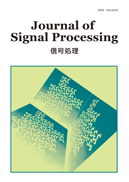All issues

Volume 17 (2013)
- Issue 6 Pages 215-
- Issue 5 Pages 167-
- Issue 4 Pages 99-
- Issue 3 Pages 39-
- Issue 2 Pages 21-
- Issue 1 Pages 1-
Volume 17, Issue 2
Displaying 1-2 of 2 articles from this issue
- |<
- <
- 1
- >
- >|
-
Atsushi Kajihara, Tetsumi Harakawa2013 Volume 17 Issue 2 Pages 21-27
Published: March 15, 2013
Released on J-STAGE: March 15, 2013
JOURNAL FREE ACCESSThe photovoltaic-cell(PV-cell) and natural energy production systems have been much attracted. Due to global warning, and extensive applications of solar power electric generation, defects on PV-cell under the partial shading become interesting technical issue. This paper investigates the equivalent circuit model and its characteristics under the partial shading condition. As a consequence the new MPPT (maximal power point tracking) method has been proposed for the sake of drastic energy generation improvement.View full abstractDownload PDF (925K) -
Daiki Nishimura, Toru Nakashika, Tetsuya Takiguchi, Yasuo Ariki2013 Volume 17 Issue 2 Pages 29-38
Published: March 15, 2013
Released on J-STAGE: March 15, 2013
JOURNAL FREE ACCESSThis paper introduces a multi-pitch analysis method using specmurt analysis without modeling the common harmonic structure pattern. Specmurt analysis is based on the idea that the fundamental frequency distribution is expressed as a deconvolution of the observed spectrum by the common harmonic structure pattern. To analyze the fundamental frequency distribution, the common harmonic structure needs to be modeled accurately because it is often unknown while the observed spectrum is known. It is considered impossible, however, to obtain a highly accurate model of the structure since it can vary slightly depending on the pitch. Therefore we propose a method to analyze the fundamental frequency distribution without modeling the harmonic structure. We note that each peak of the observed spectrum indicates the fundamental frequency or the harmonic tone. Hence, the fundamental frequency distribution can be regarded as the set which only has the peaks corresponding to fundamental frequencies. To find the set, we prepare many sets of the peaks of the spectrum, and obtain a large number of common harmonic structures. We evaluate the sparseness of these structures using L1 or L2 norm, and then select the set that has derived the sparsest structure as a solution. The experimental result shows the effectiveness of the proposed method.View full abstractDownload PDF (1688K)
- |<
- <
- 1
- >
- >|